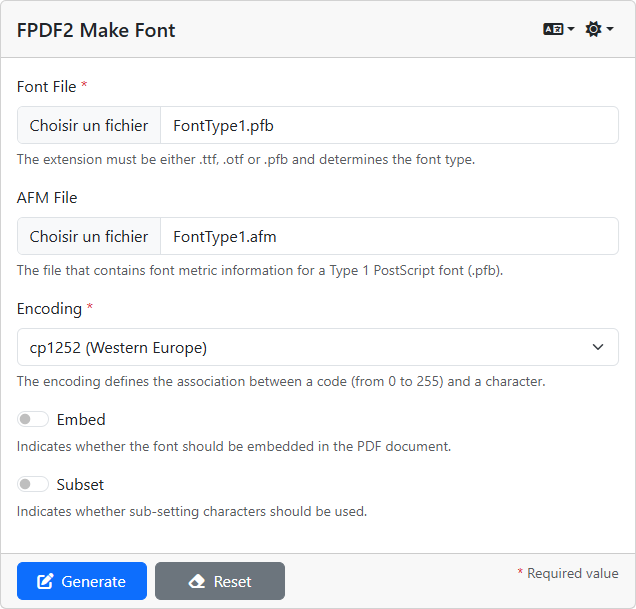laurentmuller / fpdf2-make-font
FPDF2 make font is a PHP application to generate fonts.
Installs: 450
Dependents: 0
Suggesters: 0
Security: 0
Stars: 0
Watchers: 1
Forks: 0
Open Issues: 0
pkg:composer/laurentmuller/fpdf2-make-font
Requires
- php: ^8.2
Requires (Dev)
- bamarni/composer-bin-plugin: ^1.0
- phpunit/phpunit: ^11.0
README
This repository is used within FPDF2 to create font definitions.
All code is copied from the FPDF created by Olivier PLATHEY.
Function:
makeFont(string fontFile [, string encoding [, boolean embed [, boolean subset]]])
Parameters:
fontFile: The path to the.ttf,.otfor.pfbfile.encoding: The name of the encoding to use. The default value iscp1252.embed: Whether to embed the font or not. The default value istrue.subset: Whether to subset the font or not. The default value istrue.
The first parameter is the name of the font file. The extension must be either
.ttf, .otf or .pfb and determines the font type. If your Type1 font is
in ASCII format (.pfa), you can convert it to binary (.pfb) with the help
of Type 1 utilities. For Type1
fonts, the corresponding .afm file must be present in the same directory.
The encoding defines the association between a code (from 0 to 255) and a
character. The first 128 are always the same and correspond to ASCII; the
following are variable. Encodings are stored in .map files. The available
encoding ones are:
- cp1250 (Central Europe)
- cp1251 (Cyrillic)
- cp1252 (Western Europe)
- cp1253 (Greek)
- cp1254 (Turkish)
- cp1255 (Hebrew)
- cp1257 (Baltic)
- cp1258 (Vietnamese)
- cp874 (Thai)
- ISO-8859-1 (Western Europe)
- ISO-8859-2 (Central Europe)
- ISO-8859-4 (Baltic)
- ISO-8859-5 (Cyrillic)
- ISO-8859-7 (Greek)
- ISO-8859-9 (Turkish)
- ISO-8859-11 (Thai)
- ISO-8859-15 (Western Europe)
- ISO-8859-16 (Central Europe)
- KOI8-R (Russian)
- KOI8-U (Ukrainian)
Of course, the font must contain the characters corresponding to the selected encoding.
The third parameter indicates whether the font should be embedded in the PDF or not. When a font is not embedded, it is searched in the system. The advantage is that the PDF file is smaller; but if it is not available, then a substitution font is used. So you should ensure that the required font is installed on the client systems. Embedding is the recommended option to guarantee a correct rendering.
The last parameter indicates whether sub-setting should be used, that is to say, whether only the characters from the selected encoding should be kept in the embedded font. As a result, the size of the PDF file can be greatly reduced, especially if the original font was big.
After you have called the function (create a new file for this and include
make.php), a .json file is created, with the same name as the font file. You
may rename it if you wish. If the case of embedding, the font file is compressed
and gives a second file with .z as extension except if the compression
function is not available (it requires Zlib). You may rename it too, but in
this case you have to change the variable $file in the .json file
accordingly.
Example:
require('src/makeFont.php'); makeFont('C:\\Windows\\Fonts\\comic.ttf','cp1252');
Which gives the files comic.json and comic.z.
Then copy the generated files to the font directory. If the font file could
not be compressed, copy it directly instead of the .z version.
Another way to call makeFont() is through the command line:
php src\makeFont.php C:\Windows\Fonts\comic.ttf cp1252
Declaration of the font in the script:
The second step is straightforward. You only need to call the addFont()
method:
$pdf->addFont('Comic', PdfFontStyle::REGULAR, 'comic.json');
And the font is now available (in regular and underlined styles), usable like
the others. If we had worked with Comic Sans MS Bold (comicbd.ttf), we would
have written:
$pdf->addFont('Comic', PdfFontStyle::BOLD, 'comicbd.json');
Full Example:
Now let's see a complete example. We will use the Ceviche One font. The first step is the generation of the font files:
require('src/makeFont.php'); makeFont('CevicheOne-Regular.ttf', 'cp1252');
The script produces the following output:
- Font file compressed:
CevicheOne-Regular.z. - Font definition file generated:
CevicheOne-Regular.json.
Alternatively, we could have used the command line:
php src\makeFont.php CevicheOne-Regular.ttf cp1252
We can now copy the two generated files to the font directory and write the script:
use fpdf\Enums\PdfFontStyle; use fpdf\PdfDocument; $pdf = new PdfDocument(); $pdf->addFont('CevicheOne', PdfFontStyle::REGULAR, 'CevicheOne-Regular.json'); $pdf->addPage(); $pdf->setFont('CevicheOne', PdfFontStyle::REGULAR, 45); $pdf->write(10, 'Enjoy new fonts with FPDF!'); $pdf->output();
Symfony
A Symfony application has been created to generate fonts.

